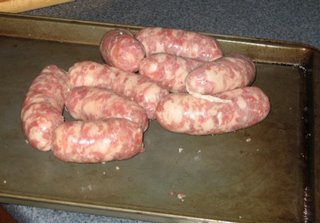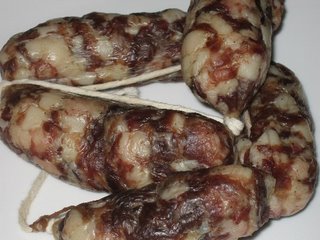As we were planning our move from FL to MA, I realized that one of the benefits of moving up to the "frigid north" is that the winter creates the perfect environment for curing meat in the basement. I know, so I'm a little different than most people.
So I started to research the possibilities to see if this was mere fantasy or if it could realistically work out. I learned that I needed a cool, dry environment - 50-55F with 30% humidity or less (update: turns out, 60-70% humidity is ideal. Oops). Music to my ears. My basement is the perfect place for this from around November through April. Should I start out small or should I go after a serious project? I checked out this book which was full of great information. Prosciutto - the holy grail, would be awasome - but the 400 days it takes to cure is ridiculous. I decided to try something a little more basic.
I found this article by Josh Friedland called "The Art of the Cure," which described this journalist's introduction to the meat curing world. He decided to make guanciale - a cured Italian bacon made from hog jowls (yes, that would be the cheeks - the ones on the face). The description sounded delicious and at a short 6 weeks, I wouldn't have to wait too long to see if this whole process worked. I decided to give guanciale a go and see what happened.
The first challenge was actually finding hog jowls. I don't know if you've looked closely in the meat section of the grocery store, but hog jowls are not a particularly common item. I decided to look in some more "low end" stores that tend to stock these cheaper, undesirable cuts of meat. No luck. I even tried a local Chinese market by my house. They had pork ears, pork tails, pork intestines, hearts, feet, liver, and kidneys - but no jowls. My plan was falling apart before I even started. Eventually, I located a local farm that could deliver - but I would have to wait 4-6 weeks.
I decided that I didn't want to risk having the winter go by without trying any type of curing experiment, so I needed to come up with a plan B in short order. I called my Italian friend Lamberto to get his family's recipe for cured, dried sausage. I'm not going to say how this happens, but let's just say that I have had the opportunity to try some of this imported meat product. A quick call to Italy and I had my recipe. Pork meat (shoulder would do nicely), fat back, salt, and black pepper. Also, I would need some type of casing to stuff this in. Fortunately, all of these materials were easily obtainable. With raw materials in hand, my career in meat curing had begun.

Cutting the Pork Shoulder
 Mixing the Fat and Seasonings
Mixing the Fat and Seasonings

Don't ask how this got stuffed in the casing - Let's just say that it wasn't pretty.

Cool, dry air - do your magic
Now, all that was left was to wait. In the grand scheme of things, two weeks is nothing. But when you are living with great expectation and anticipation, it can seem like an eternity. After a mere 8 hours, I bubbled with glee as I studied the hanging meat - my fine handiwork. I could already detect a slight change in the color and surface moisture content. Over the next couple of weeks, I would run down to the basement dozens of times just to check things out. Finally, it was time.

The finished goods
It was at this point that I made the mistake of researching the potential dangers of home cured meats. After some consideration, I had elected not to use nitrites as part of my curing mixture. I don't want to get into the technical details, but suffice to say that if you want to be absolutely sure that your cured meat is safe, use nitrites. However, they can transform into carcinogenic nitrosamines and may have potential health risks. Salt alone will prevent almost every harmful bug from surviving, but without nitrites, it is possible for one ugly food poisining situation to occur. If you want to read about botulism, be my guest. Keep in mind that sometimes, ignorance is bliss.
I was never really concerned about this danger, but as I held the first slice of meat up to my lips, the potential pain and suffering seemed to come to life in my mind. I chewed quickly and swallowed. I would wait a full 72 hours before pronouncing the meat "safe."
Having survived with no health effects, I brought the sausage in to work to "test out" on some of my co-workers. By now, I felt the freedom to enjoy the tasty morsels without irrational fear. The texture of the sausage was a little drier and harder than I was hoping for (update: due to overly dry environment), but sliced thinly, it had a nice texture. The flavor was outstanding. It had the sweet taste of supremely fresh pork, with a nice salty bite and a hint of black pepper. I was very satisfied with my first venture, but had not forgotten about my original plan to make guanciale.
Fortunately, my supplier had finally come through. The voicemail indicator on my cell phone was lit up. "Rich, we have your jowls."
Part 2 - Getting Cheeky
Part 3 - The Tasting



4 comments:
Note to self: Stop reading website entitled 'Pork is my Friend.'
And never go into the Pyatt's basement.
Don't worry Karyn, I'll have some stuff for you too! Keep the faith.
I will try some, if it is still around when I get there!
Will you share the detailed recipe? I would love to try it!
Post a Comment